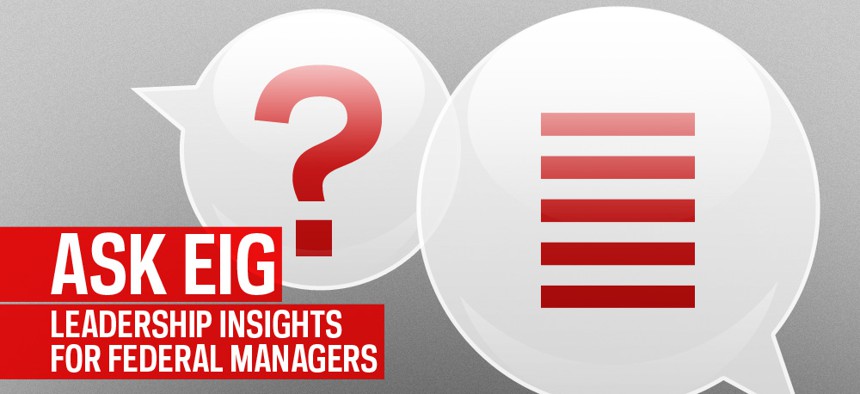
Ask EIG: How Do I Motivate and Retain Talent During Sequestration?
Perspectives on motivating your team in the face of looming budget cuts.
![]()
Ask EIG is a partnership between Government Executive and the management experts at Brookings Executive Education.
Dear EIG,
I would like to retain my high performing Intelligence agency's analytic workforce, keep them motivated to deliver first class services, and ensure they feel a government career is a worthwhile endeavor. Anticipating departmental budget cuts due to sequestration, how do I achieve these objectives when they are confronted with the long term prospects of limited promotion opportunities, pay freezes, curtailed professional training and education, and increased workload?
In reading your question my mind kept drifting to the imagery of a rock and a hard place. The growing gap between government revenue and expenses/obligations has ushered in an age of austerity and shrinking budgets that have conspired to create unprecedented fiscal pressure on federal agencies. Instead of the ever-present call to “do more with less”, agencies now are struggling to “do the same with less, a lot less”.
(HAVE A QUESTION? Send your management questions to AskEIG@govexec.com)
As with past budget crises, organizations first respond with substantial cutbacks on traveling and training. Hiring and promotion freezes, buyouts, and reductions in contractors are the next tactics deployed. With a prolonged crisis, positions are cut, experienced and productive workers retire or leave for the private sector, work is reassigned to an increasingly overloaded workforce, and motivation spirals downward into what seems like a hopeless abyss. What is different in the current crisis is that some say fiscal pressure may persist for a decade or more. How can worker motivation not hit bottom?
The good news is that you are facing the crisis with an already high performing workforce. And, even with the dire situation, I believe that you still have opportunities to maintain your workforce and keep them motivated. To discover these opportunities, it is useful to think of worker motivation as coming from three different sources.
- Economic: The first source might be thought of as economic. If people expect to get ahead in income and position, they are more likely to work hard and stay put to achieve these outcomes. The key leadership issue is how you can create and reinforce expectations that working hard will eventually bring economic rewards.
- Social and Emotional: The second source can be thought of as social and emotional. If people enjoy working together as a team, respect each other, feel ownership for the work they are doing, and have deep social attachments to each other, then they are more likely to stay together and keep each other motivated. The key leadership challenge is how you can help create and support deep social attachments within the team.
- Ideological: The third source can be thought of as ideological. If people have a deep and passionate beliefs about what they are doing then they are more likely to work hard to achieve their ideological goals. The key leadership challenge is how you can help workers associate with, reinforce, and elevate an ideological commitment to their work.
Stimulating any of these three sources of motivation will require your imagination and creativity, especially given the pressing constraints that you face, as there is no silver bullet. With limited ability to offer economic incentives, I recommend that you get creative and find ways to keep investing in your workforce’s professional development. For instance, increase your mentoring efforts; find new ways to bring to them valued leadership and technical development opportunities; keep investing in their capabilities. Doing so can increase productivity and demonstrates a commitment to increasing their professional potential, which will give them more opportunities in the future. While investing in these capabilities may eventually lead to great people moving on to other jobs, doing so sends a positive signal that will attract a pipeline of desirable hires when the option opens up.
You also can invest in deepening--and repairing if need be--social attachments within the social fabric of your team. I recommend that you appreciate what your team accomplishes each and every day. Seek out positive stories and share them broadly. Perhaps even more important is to encourage your team members to appreciate each other. Mutual appreciation can build and sustain teams. In my own research on teams I discovered that the most productive workers often are willing to earn less just to stay with teammates who appreciate them.
Finally, you can find ways to further stimulate their commitment to public service. Serving the public is not always easy and not always well remunerated. Yet people choose to do so because it represents a higher calling, a service to society and making the world a better and safer place. Just as our nation, in a myriad of ways, has renewed its interest in honoring those who serve in uniform, I recommend that you and all of us acknowledge and honor those who serve the public good. Doing so frequently can stimulate your workers public service motivation.
To be sure, keeping your workforce motivated to deliver first class service must seem like being between a rock and a hard place. Yet through your imagination and creativity you can make headway on retaining your high performing workforce by leveraging these three sources of motivation. With the importance of intelligence analysis, our nation depends on it.
Duce a mente (may you lead by thinking),
Jackson Nickerson
In partnership with Brookings Executive Education, Excellence in Government is now taking, and answering, your most difficult management questions. Send your questions to AskEIG@govexec.com.







